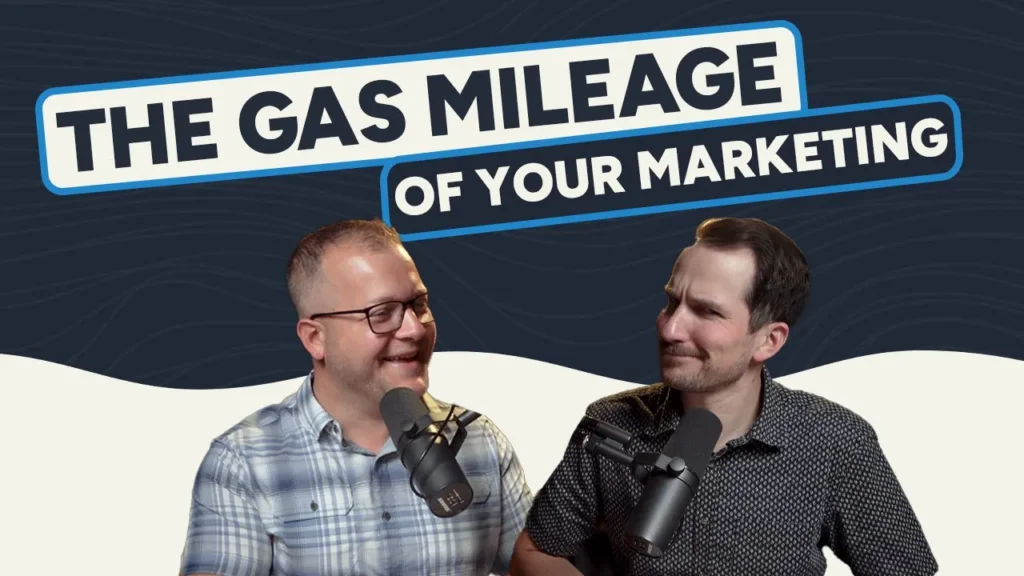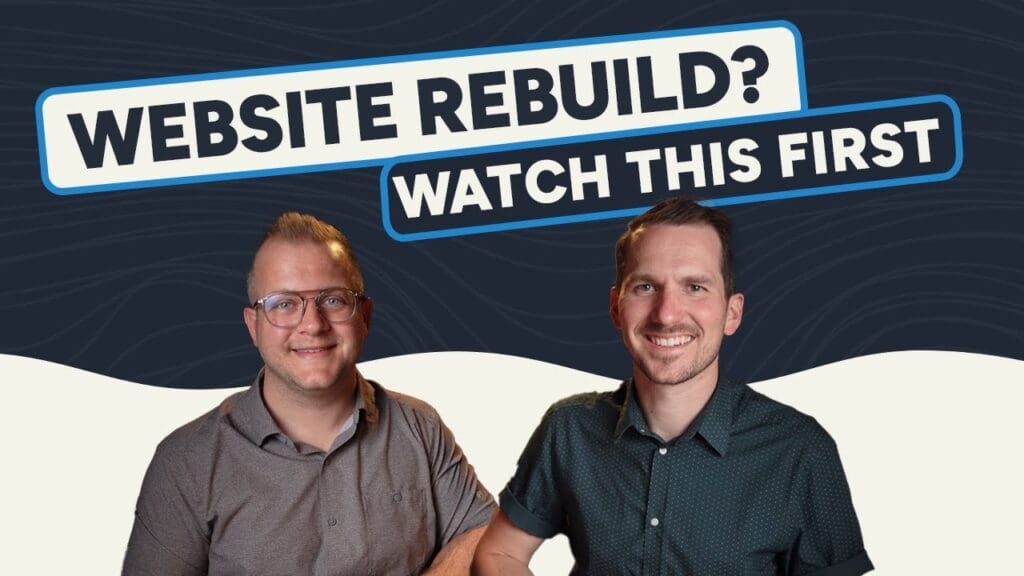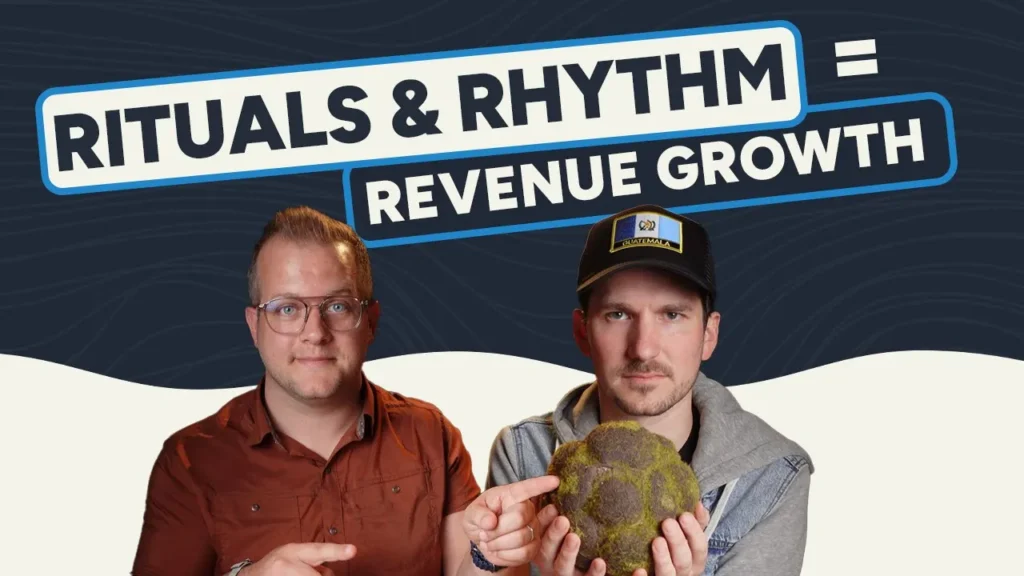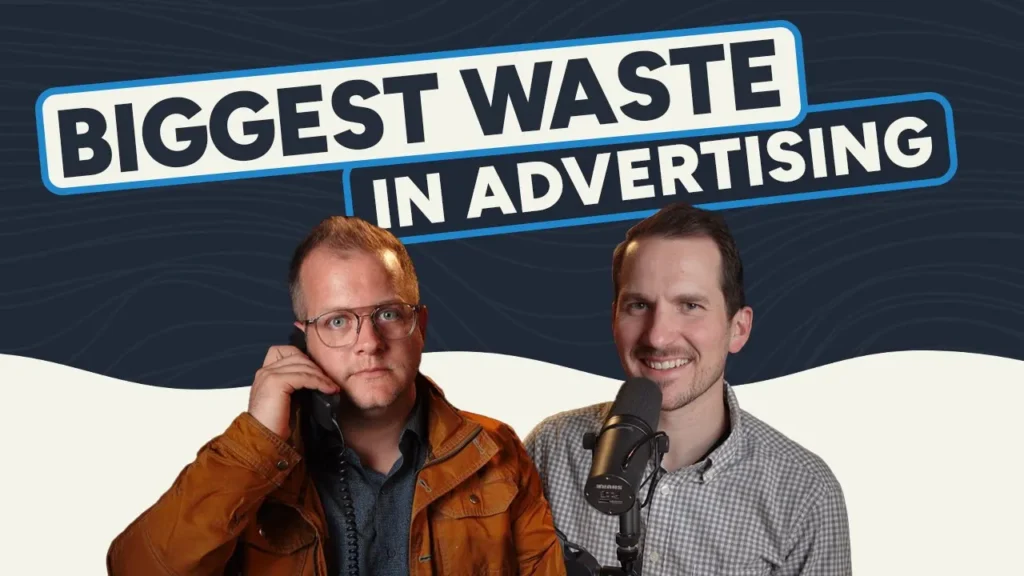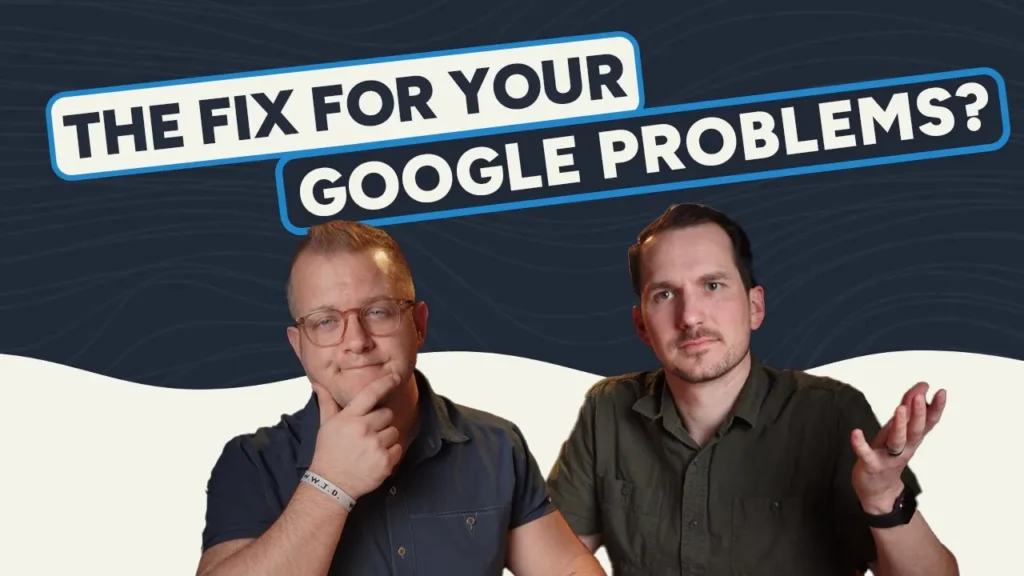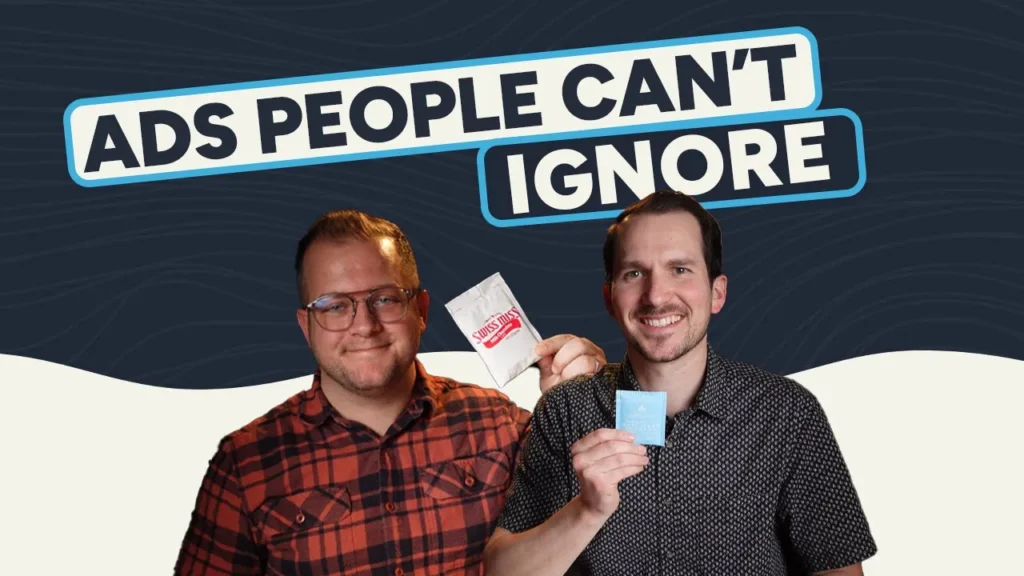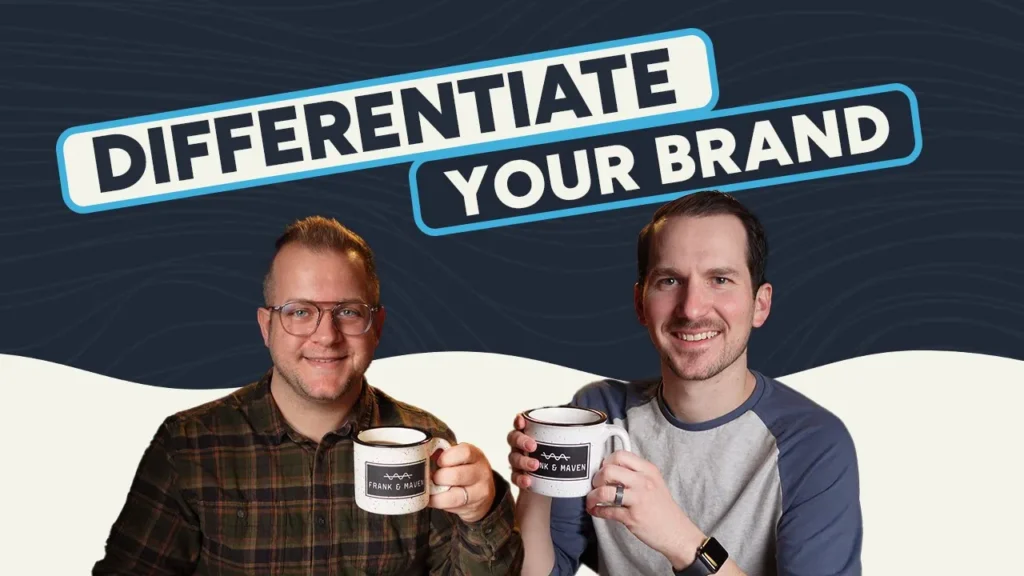How to Write More Effective Ads in 2024

Our Website: https://frankandmaven.com/
Buy Our Book: https://www.amazon.com/Maven-Marketer-Advertising-Legendary-Business/dp/1735846708
Instagram: https://www.instagram.com/frankandmavenmarketing/
TikTok: https://www.tiktok.com/@frankandmaven
Twitter: https://twitter.com/frankandmaven
LinkedIn: https://www.linkedin.com/company/frank-and-maven/
This Episode Hosted by:
Recent Episodes:
What Are CPMs? The Gas Mileage of Your Marketing
Rituals & Rhythm = Revenue Growth
Get New Episodes In Your Inbox:
We'll be back every Monday answering your real life marketing questions!
Listen to Audio Only:
Keep Sharpening Your Marketing Skills With The Maven Marketing Podcast
What Are CPMs? The Gas Mileage of Your Marketing
CPMs are the great equalizer of marketing media. To make great decisions, you need to know how…
Rituals & Rhythm = Revenue Growth
Culture eats strategy for breakfast—and in this episode, Brandon Welch and Caleb Agee show you why rhythm…
The Single Biggest Waste In Advertising
You might think the biggest waste in advertising is bad creative, weak targeting, or outdated platforms. But…
IDKWNTHTB – Keep Showing Up!
Every business owner hits the wall. You launch the campaign, tweak the copy, show up every week—and…
Stop asking, “How did you hear about us?” (do this instead)
It’s lurking… tucked into a form on your website or maybe it’s a part of your sales…
IDK Who Needs To Hear This But: You Need To Fill One Glass At A Time
FREE MARKETING AUDIT: MavenMarketingAudit.com Get a copy of our Best-Selling Book, The Maven Marketer Here: https://a.co/d/1clpm8a Our…
How to Immediately Differentiate Your Brand
There are no more unique value propositions. You could invent the next big thing and you’ll have…
Caleb Agee 0:00
The natural bent when I’m spending money for my business, about my business in advertisement, I get a little bit narcissistic. Oh yeah, on accident, right off the bat, because it’s me, me, me. I’m paying the
Brandon Welch 0:14
money for the ad. Yeah, it’s about my product, my service. They need to be educated about my product.
Caleb Agee 0:18
They need to know about and if they would come and buy, and we have to, we wrong. We have to get off of that, off of that, you know, pedestal and say, yep. Hold on. The customer is the one, the hero in this story, yep. And if I can elevate them and make this all about them, I will win every single time you welcome to
Brandon Welch 0:44
the Maven Marketing Podcast. Today is Maven Monday. I’m your host, Brandon Welch, and I am rejoined by my co host Caleb, aka Jim Halpert. Agee, you know it’s,
Caleb Agee 0:57
yeah, it’s been a I’m a big office fan, in case you didn’t know, so you can tell me, I’m he said, Did you call me? It is Halloween. It is Halloween. At the time of recording
Brandon Welch 1:08
of this recording, and so Caleb was dressed up as somebody he is not his idol and mentor in office life. Mr. Jim Halpert, yeah.
Caleb Agee 1:18
And I’m the reigning office champion, Frank and Maven. I made
Brandon Welch 1:21
him take the three hole punch the rest of his costume. Yeah, I had bad deal. I had a three hole
Caleb Agee 1:25
punch Jim going on. If you can tell me what episode three hole punch Jim is from hint Halloween episode, if you can tell me which one he’s run, we’ll send you 100 bucks worth of swag. Frank and Maven, swag. Maven swag, not gonna be random swag. Probably throw look at this coaster. No, we got we got stuff better than that. We got in the coaster, mugs, shirts. There’s
Brandon Welch 1:47
stuff you don’t even know about. Oh yeah, got a whole closet go to the vault. Speaking of apparel, apparel, my wife tripped this morning with two full laundry baskets. I watched the whole thing unfold. Okay,
Caleb Agee 2:07
I’m happy to be back. By the way,
Brandon Welch 2:08
I’m so glad you’re back. It’s good to be back. It seems like ages since you’ve been on here, ages
Caleb Agee 2:12
since you’ve ages Yeah, you missed your chance there. But need the
Brandon Welch 2:16
camera guy is going to cut out that awkward white space and make that sound like we’re not five minutes into the podcast, but if you like those, I have a whole laundry list of them later. So, so this is the place where we answer your real life marketing questions to help you eliminate waste in advertising, grow your business and achieve the big dream, the big dream, and what are the big dreamers up to this week?
Caleb Agee 2:40
Okay, well, we’ve gotten a lot of questions, mostly around being creative, especially in their ads. And so one is from a national group in the medical space. They’re asking how to make their ads perform better for a specific product. And another, we’ve gotten a couple of nonprofits that have asked us about how to get more donations and support during the holiday season. Love it. So we need to
Brandon Welch 3:05
do a whole episode for our nonprofit friends. I love it. We’re gonna do that. We’re gonna
Caleb Agee 3:09
it’s happening. Nate the camera guy. Write that down. He’s gonna make it. So this episode, we need to make it all about writing more effective ads. Writing
Brandon Welch 3:19
more effective ads. It just so happens we wrote a book about that, but specifically we wrote an entire chapter about that. And so I’m ripping out, ripping off chapter seven of the maven marketer. You
Caleb Agee 3:32
don’t even need to read it anymore. Even get it. I’m just kidding. You gotta read the copy, and
Brandon Welch 3:36
we’ll send you a copy. Hey, the hardbacks out. Oh, it’s on Amazon. It’s got like, a three week delivery time. So I don’t know what that’s all about, but it’s but it is out, and you can order it on Amazon. Takes me a long time to put them together, but, but if you are an advertiser, somebody who’s just going, Ah, things are getting a little harder. If you’re going, uh, never really had awesome ads. I know if they’ve done me some good, but I’m not quite sure. I don’t feel it quite the way I’d like to. Or if you’re a media person and you’re going, man, 2024 is not looking to be easy street, right? And so the biggest leverage you could possibly have, whether you were selling advertising, buying advertising, or helping somebody else make it work, is the sanctity of the words that you use in your ads, the message, the message. And I’m going to gloss over that, because, frankly, the industry for a long time has said, Oh, it’s all about your creative and that is true, but it’s not necessarily about creativity. It’s more about what I’m going to call strategic messaging. And I broke this down to three parts this week, and we’re going to first look at what are you really selling? Because that’s where it gets off the rails every time, every time anybody who’s seen a painful local ad, they didn’t realize what they were selling, or if they did, they forgot to put that in the dadgum ad. It sounds weird. I promise you’re going to go, Oh my gosh. How did I miss that? They were going to talk about crafting a strategic message, so not just making a creative message now that that is important creates. Creativity, can help us earn and hold attention, but we’re gonna talk about formatting your message in a way that the human brain, and frankly, the human experience is designed to absorb and do something about it. Yeah, and then my favorite of all, we’re gonna make them want to specifically buy from you, not just your product because you wrote a good ad, not just a good ad, not just a product that any of your competitors or, sorry, an ad any of your competitors could write about a similar product. We’re going to make them want to buy it specifically from you. This is going to be a two part episode, and we’re going to dive right in because there is so much here. I think this is the thickest stack of papers ever brought into this podcast room. And so we’re jumping right in. So we’re talking about, what are you really selling. Now, that sounds obvious. Well, I’m an eye doctor. I sell eye doctor things. I sell glasses, glasses and vision exams and stuff. Wrong, wrong, wrong. SNL episode, I just want all Trump on you. Wrong. Eye doctors are not selling glasses. What are they selling? Caleb,
Caleb Agee 6:00
they’re selling the ability to watch your daughter’s wedding in full detail, in full detail. They are selling better grades for your kids. They can see the board. They’re selling a
Brandon Welch 6:13
good night’s sleep. They’re selling moms not being tired in the afternoon because your eyes have so much to do with how your body strains and how your brain fog happens, they’re selling fewer headaches. They’re selling better performance at work, right? Yeah,
Caleb Agee 6:28
yeah, sports performance even, oh
Brandon Welch 6:32
yeah, you’re selling a better golf game. Yeah? These particular pick right now you gotta Yeah, yeah. These particular doctors that I’m thinking of actually have a full wing of their business that is specifically helping people train their vision to be better sports. You know, athletes, what are attorneys selling? Are they selling estate plans and litigation and contracts?
Caleb Agee 6:57
No, they’re selling. I would say it’s like locking in your legacy, making sure that nobody’s gonna fight when you’re gone. You know,
Brandon Welch 7:06
they’re selling no fights from your kids about your stuff? Yeah, they’re selling, this is very real. They’re selling friends who get into business together, not hating each other when they depart from business together, which probably will happen if you’re in a partnership. Yeah, chances are likely you will not stay in a partnership. In business hardships to sale those partnerships. But attorneys are selling peace of mind. They’re selling really comes down to like, people don’t have to fight like, I don’t want to get into divorce attorneys, because they may be selling, actually fighting and getting back at your whoever. But I use the example of estate planning terms. They’re not selling estate plans. They’re selling families that don’t fight luxury restaurants are not selling fancy food. They are selling a way to feel important. They’re selling date nights. They’re selling closing business deals. They’re selling connecting with new and old friends. It’s not about the food. The food is just a means to an end feeling a certain
Caleb Agee 8:06
way, almost even like a conversation piece, right? Yes, that’s a that’s an anecdote at your next party, or wherever you go, you’re like, Have you tried the food? Yes, this place? Yes. So good. Yeah, exactly. Yeah. That’s, that’s status. They’re
Brandon Welch 8:21
selling status, right? No secret, we work with a lot of window siding remodeling type companies. Window companies are not selling windows. What are they selling?
Caleb Agee 8:29
Keeping the cold air where it needs to be and hot air where it needs to be. Yes,
Brandon Welch 8:34
they’re selling being comfortable in your living room. Yeah, they’re selling no more drafts, no no more chills and no more bills. Yeah, sound protection, yep. They’re selling a quiet baby’s room. They’re selling compliments from your mother in law. They’re selling compliments from your neighbors. They’re selling better carb appeal. Nothing to do with Windows, right?
Caleb Agee 8:55
Enjoying the spring air because you can actually open the window. Okay? Non
Brandon Welch 8:59
Yeah, exactly, yep, okay, nonprofit friends, this one is for you. This is going to hurt a little bit. Okay. I do not want to be the bad guy, but I hate to tell you whatever it is you’re doing good for the world. I believe in it, and I believe it is worthy. So do not hear me wrong here, but when you were talking about motivating somebody to support you, even somebody who has a deep and close connection to your cause. You are not selling donations. You’re not selling support our cause. You are selling a way for somebody to not feel guilty. You are selling a way for people to feel good about themselves and the and their purpose, you’re selling fulfillment of a person’s innate desire to be a good human. That seems like a subtle shift, but the more you understand that, and the more you understand that you have to turn up that pain and make them feel that pain so that they go, Oh my gosh, my life is so much better. Better than than this, or my life is so much better because of this cause. Or I’m so grateful I never had to deal with that lot in life. I just feel this emptiness, and I want to help that is what you’re actually selling. So what are you selling? Caleb has a favorite quote,
Caleb Agee 10:19
yes, made the book. Nobody wants a half inch drill bit. They want a half inch hole. And if we take it beyond that, if we’re going to half inch drill bit, what are you making? A swing set or something like that. You want your kids?
Brandon Welch 10:31
Valerie. Valerie. Valerie would really like that shelf hung up or Yeah,
Caleb Agee 10:36
shelf hung up on the wall. You’re Yeah, yeah. I don’t know if you’d use half somebody. It’s a
Brandon Welch 10:41
big drill bit for I don’t know, but you’re not selling the drill bit. You’re selling half inch holes. And so that is the paradigm, that’s the lens we want to start looking at everything. So where this happens a lot. Love you media reps, but I want you to slow down. And instead of just saying, Oh, it’s all about the creative, we’ve got the super creative we’ve got this super creative guy back at the station. You are the consultant. You’ve spent more time with this business owner than anybody. You have the unique position of being inside their employee mix. You have talked to their people. You should be interviewing their frontline people. You should be interviewing their customers. You should be figuring out what in the heck this company actually sells, yeah. Or if you’re the business owner, you should be employing somebody, hiring somebody or trusting somebody outside of your bottle every day to look and say, what outcome do we really provide? Yeah, I have a few questions you might be able to use ask, what is the moment of joy that this person gets, this end customer gets when they buy this thing. Where’s the joy? And you can take this all the way down to when they actually have their hand on the product. Or you can actually say when, what are they going to be in a moment where they go, man, I’m they’re telling a friend. You’ll never believe I hired this company, or I bought this product, or you should try this. Or I, man, I love these tires, or I love this brand of automobile. Or there’s nothing like you know when you can call my guy and he just takes care of it for me, right? Or my gal, yeah? When are they going to be glad they made that decision? Socially, internally, externally? What is the moment where they feel secure and like really glad that you’ve partnered with them? No matter what you’re selling, it could be an E com product all the way down to a service that’s provided by brick and mortar. So ask, what are they going to feel? Relief, joy, encouragement, delight, confidence. That is a clue that that’s what you’re actually selling, and what’s the moment they’re going to desire to buy it from you specifically. We’re gonna talk about that in point three. But take this a step further. We had to hire a heating and air company recently, and there was one that just popped in my mind, because I actually don’t know this guy, but they’re, they’re, I guess their ads and generally, just generally, their reputation, made me feel like I already had a guy, right? Yeah, and so when are they going to desire to buy it from you specifically? We’ll talk about that in a minute. But recap real quick. The first thing is understanding what you’re selling. You are not selling your silly product. We are not selling advertising, by the way. We’re not selling marketing services. We’re not selling Nate the camera guy, we’re not selling video production. We’re not selling words, we’re not selling graphics, we’re not selling media plans. Yeah, what are we selling?
Caleb Agee 13:32
Well, we’re selling, I think, confidence and growing a business. But then even beyond that, that’s the thing. There are layers to all of these. What are you really selling? And I want to, I’m going to time out real quick, because I think it’s important there’s like, the first layer is, is the obvious, it’s just the product, it’s the features, it’s the benefits, right? If we’re talking about marketing, it’s like, you get good ads, right? Yes, that’s not what we’re really selling. But then a layer deeper is, your company grows because of good ads. But if we want to go even deeper, your dream as an entrepreneur, to grow your business and retire at a certain time, to provide for college, for your family, to get to take cool trips, that’s where we go, to give your church to deeper and deeper. And we’re going, we’re trying to find, probably a deeper level. It really depends a little bit on your goal for the ad, I think. But we want to take it a couple steps, a couple layers, media
Brandon Welch 14:24
salespeople, the business owner will always, always, always, always tell you, I want to sell more widgets, or I need more customers. Yes, they don’t need more customers. They need those things. Caleb just said, Yep, I should ask Nate the camera guy, we exist. What Frank and Maven does to create a world where entrepreneurs can confidently grow their business without wasting money on advertising. Everybody here says it every week. That is part of our ritual and our Monday morning church at Frank and Maven. But you should know that you should have that clarity. What do we do around. Here the strongest companies I’ve ever seen, the leader or the frontline salesperson or the janitor. Could all tell you. What do we do around like
Caleb Agee 15:08
that old JFK story where he was walking through NASA and the man mopping the floor, he said, What are you doing here? He said, I’m putting a man on
Brandon Welch 15:16
the moon. Putting a man on the moon, that is it. Have that organizational clarity, because nobody’s sitting around going, Gosh Golly. If I only had a plumber with 62 years of combined experience, or, gee whiz, if I only had an ASE certified mechanic your one stop shop for I didn’t wake up going, dang Oh Pete, if my eye doctor just had five convenient locations? Yeah, no, I’ll wake up going, Wow, that’s blurry. Looks a little blurry. Much better office reference off the chain today, you wake up going, Man, I have a headache. Or you wake up going, oh gosh, am I giving my kid all they need to succeed. So what are you really selling? Anything you would add to that,
Caleb Agee 15:55
I think, don’t stop until you’ve explored the depths of those layers of the what are you really selling? If you stop at the first level, you probably are going to miss a really appropriate angle, which usually is where you need to start your ad, because you need to speak to it’s usually that when you go deeper, let’s go with Frank and mavens. Example of you get to take trips. You’re not a slave to your business because it’s grown. Oh, yeah, past where you where you want it to
Brandon Welch 16:24
be, yeah? Randy, our friends last week, our friend reality, that
Caleb Agee 16:27
is their reality, and they can leave home. Yep, the place isn’t going to burn down when they leave. And that is the outcome that Frank and Maven wants to sell, right? Yep, that would be a beautiful start to an ad. Yes. Imagine getting to leave the office and not worrying that the whole place is going to blow up, and
Brandon Welch 16:44
it’s because you have a steady stream of customers. You have clarified your messaging, you’ve clarified your mission, all part of the Maven method, by the way, in the Maven marketer, you have clarified your vision for the world, and everybody gets it. So you’re not slave to driving this thing, right? Everybody gets it. Yep, think you know what, you guys do that for me. Thank you so much. Oh, you allowed me to do that, and we allow our team to do that, right? Yeah, um, how many times you’ve been called on vacation? Caleb is a big freaking deal around here, okay, Caleb, Caleb, like, does all the things, and we have built a business that even Caleb, yeah, doesn’t get called on vacation. Okay, all right, understand what you’re selling. Understand the outcome, you know, Frank and mavens outcome, because this is where ads fail. This is the first place they fail. And I’m telling you, nine out of 10 of them fail at this. And so get that right? Don’t let the person in the media, God bless them. They’re doing their job, but they need to do a little bit more than their job to get the result that we all need for all this stuff to work. Yes, because life or death of your ad is, do you understand what you’re selling? Second thing, okay, we’re gonna get through part two, or sorry, we’re gonna get through this and then we’re gonna land this. And finish Part Two next week. But the second thing is using the Maven method to craft a strategic message, okay, so we understand what we’re selling. Now. There’s a four part formula. It’s in chapter seven, and all throughout the Maven method you guys have heard if you’ve listened to the podcast before, part one is, step one is,
Caleb Agee 18:24
Who are you talking to? Step two is, what are the needs, pains, hopes and fears. Step three is, how can my product satisfy one of those needs, pains, hopes and fears. And step four is, what’s a reasonable next step for action? Love it. That is
Brandon Welch 18:37
so innate here. Anybody who does anything in our organization, and hopefully anybody who’s within 10 feet of us knows that. Who are you talking to? What are the needs, pain, soap spheres? How can we specifically satisfy that? What is most reasonable next step for action? Let’s start with who we’re talking to. Here’s what happens in ADS. Here’s why ads sound like ads, and here’s why ads get ignored. Yep, we start writing about this product, and we go into this mode that is like, Ooh, I’m writing about a product. I’m making an ad now. So I must talk like an ad. And something about us just leaves humanity, and we go into this mechanical, robotic thing that we do. That’s what kills your ad. Yeah, what you want to do instead is go exactly like you were going to have this conversation with a friend in a coffee shop, and you want to say, picture this person. And you’re thinking, okay, back up for just one second. Yeah, there are a lot of different types of people who end up buying your product. Pick one, pick the last one you have had that was good. Or pick the one you’re just the most familiar with. Because when you’re writing to everyone. You’re talking to nobody when you try to write, when you try to talk like you’re broadening this thing. Human beings secretly know that message isn’t for me. They’re not talking to me like I’m me. We all know that. We all know when something’s not programmed for us. And so pick a specific person and they will everybody else will actually lean in. The 20 year old will lean in. The 60 year old. Really lean in. But you were talking to the 45 year old female, right? So you’re asking, what do they buy? What do they admire? What do they spend their free time doing? What turns them off? What turns them on? What do they read and listen to? What concerts would they go to? What restaurants do they like? What genres of music or literature do they like? How do they vote? And you’re taking this ideal it per it’s probably somebody you know. Hopefully it’s somebody you know, or have a loose assumption of. You’re getting so clear on them, you’re tuning your mind saying, I’m writing a letter to this person. My ad is not an ad. It’s a letter to this person. Yes. And then from there you start, you start thinking about how, what would be funny to this person? What would she laugh at? What would she, you know, get emotional about? What would make him, you know, stop in his tracks and go, What the heck? And the more you can visualize this person. The industry calls it an avatar, but I think it’s more than just a demographic set of characteristics. You’ve got to be able to know this person so innately that you and literally, sometimes I write my ads at coffee shops and look around at the person I think looks like somebody who should buy my clients product, and I write to them, yeah, and I’m observing them. It’s weird. I’m not telling you to like, creep on people, but I’m saying that’s how crazy you got to get about this. Okay, yep, that is the best hack I’ve ever had at writing ads that don’t sound like ads
Caleb Agee 21:24
so good. I think the natural, if I can go back to even the reason this is so important, the natural bent, when I’m spending money for my business, about my business in advertisement, I get a little bit narcissistic on accident, right off the bat, because it’s me, me, me. I’m paying the
Brandon Welch 21:44
money for the ad. Yeah, it’s about my product, my service. They need to be educated about
Caleb Agee 21:48
my product. They need to know about and if they would just know, they would come and buy and we wrong. We have to get off of that, off of that, you know, pedestal, and say, yep. Hold on, the customer is the one, the hero in this story, yep. And if I can elevate them and make this all about them, I will win every single time, yes,
Brandon Welch 22:09
yes, yes, yes. Now what you will end up finding is that every human being walks around wanting a little bit more validation, wanting a little bit more acceptance, wanting a little bit more freedom, wanting a little bit more time, and wanting a little bit more enjoyment. So you’ll find like some universal desires use the Maslow’s hierarchy. We’re not going to talk about that today, but if you want to just take a wild guess about what somebody needs, they probably need more belonging. So just keep that in the back of your mind. But you’re not talking to you’re not writing an ad. You’re writing a letter to Janet. Janet, I write ads to you all the time. You know who you are. Like, probably six out of 10 of the ads I write. And I’m like, What would Janet think about this? Because I know Janet, right, and she happens to be a fit for a lot of the products that I sell. Yep, even if she’s not, even if it’s go out to this eye doctor, example, even if she doesn’t have kids buying eyeglasses, she influences somebody who does, or somebody like her influences somebody who does. So if I write to her, I know I’ve nailed it, right? Does that make sense? Oh yeah, got that Nate the new camera guy?
Caleb Agee 23:16
I think it’s important. We’re kind of talking about crafting this strategy. But it’s important even at the end, you come back and you say, line by line, Did I did I get Janet’s attention? Yes. Did I keep it? Did I keep it? Did I keep it? Oh, I long. Did I start there? When did I start boring Janet? Yep, yep, I was talking about me again. Oh, that wasn’t right. And you
Brandon Welch 23:37
know, this like, I would never take Caleb to coffee and start talking about, like, my certifications or my years of experience, I just wouldn’t do that. I’d be like, Dude, you’re gonna love this. You know, everybody knows in a social setting, had a whole attention. We do it all the time, and we we know we have that intuition about when we’re losing attention, and we just it’s appropriate for us to mirror and validate the person we’re with. And unless you’re just a complete narcissist, you do that naturally, right? Okay, so that was the first step of writing a strategic message. Get very serious about who you are talking to or to whom you are talking the editor of the book, I’m a hillbilly, like I’m from Rogersville, so I was like, Who are you talking to? And then, though you don’t end your sentences and prepositions, and they try to make that To whom are you talking? I was like, No, wrong, wrong. Okay. Step two, what are their person? What is that person’s needs, pains, hopes and fears as it relates to the product you’re selling? This is where you start to think about your product. But you’re going, Okay, I’m selling a special contact lens, or I’m selling nonprofit service. I’ll just use an example. We have a phenomenal cause we work with that is cleaning up homelessness in Springfield. So am I selling? It’s gonna sound really bad. I’m not this guy. I’m just telling you what the what the natural skepticism that. And the person’s psyche, okay, the stereotype that happens when we’re talking about fixing the problem of homelessness, even though most people can logically go to a place where these, you know, they can understand, everybody has a story. There were some bad things that happened in their life. There’s a reason that ended up here. Yeah, we can all intellectually get there. But on the surface, it’s like alligator fight or flight brain that we have when you tell somebody we’re cleaning up the streets or we’re going to save homeless people, they’re like, ah, like, all these objections come up. What are you doing about that? That it’s why is that my problem? Right? They even want help. Do they want help? Yeah, exactly. I’ll bet you’d like to do that. I would like that to happen too. But these people, you know, they won’t take responsibility. But every person’s natural skepticism says, if I give that person $20 what, there’s a high chance they’re going to do something bad with it. Everybody’s had that experience. Everybody’s had that moment on the on the street corner, where they’re like, Oh, I’d like to help, but I don’t think I should. So what if this person said, or what if this nonprofit instead said, responsibly, help them, right? And you tell their story, and you do show that pain, we start with a not the sob story, but really, like the moment of like, where this person changed. And what I’m telling you guys to do is you’re selling the guilt factor of not helping. You’re helping somebody see so quickly that this is a problem they can contribute to. And like, the implication there is, are you a good person? And if you are, we’ve made this really easy for you. So yeah, that was a side rant about the needs, pains, hopes and fears are maybe not what you think they should be, but you’re asking, what do people actually feel when they need this product? Yeah, what are they needing? Legit? What are their pains with the buying process? If you’re selling home improvement or any sort of service, the pain is absolutely that this high pressure come into your house and force you into trying to buy something, or trying to make you feel stupid, or trying to make you feel out of control the situation that’s a pain for every buyer. The more you take that away from them, the better. That’s why we have things like a D guarantee, and we have things like, we promise we’ll be in and out of your house and x, y, you know, in 30 minutes or less. Yeah. What are their hopes, the moment where they’re telling their friends that they made this awesome decision to go with you could be hopes. I leave my kids with peace, and you know, no doubts about their future or what I wanted to have happen. If you’re an attorney, let’s go to like mechanics, their hopes are, I don’t have to ever be embarrassed about my car breaking down in the school line, right? Yeah, my hopes are I don’t want my car to make that noise. I don’t want people looking at me. Let’s go to give me a give me a category Nate. Go to plumbers. My hope is that I don’t ever have to have this problem again. I’m not embarrassed. My home value stays high. Yeah, think about the moment of joy that person has right and maybe the bigger life term outcome, and then the fear making the wrong decision. What are all the fears with the wrong decisions? I paid too much. I made a choice that was temporary and not long term, right? Yeah, I chose the guy that takes advantage of little old ladies. I chose a bad, reputable company, right?
Caleb Agee 28:29
Missing out. Yeah, big fear, yep, FOMO. Exactly.
Brandon Welch 28:33
FOMO, right? Yeah. So needs pains, hopes and fears, and ideally, you’re writing these on one column, sheet of paper, make pickup, pick a legal pad and write needs, pains, hopes and fears, all the things you can think of that your customer has. Yeah. And then very simply, in the other column, how you solve each one of those needs, pains, helps, fears, which is step three. So we’ve gone through, who are you talking to? Get serious about them. What are the needs, pains, hopes, fears, how can you specifically satisfy that is step three. And inevitably, what a lot of ads do is they either bring up the product and the features, is most common mistake, or they maybe do the good thing and they bring up, you know, some void that the customer has, but they don’t specifically say how we do that, like I want bullet points. This is where, this is where you do enter,
Caleb Agee 29:21
or talk about your special treatment, the more the features benefits.
Brandon Welch 29:25
We have a nationwide client that does deck restoration. And the typical way of restoring your deck is you go to Lowe’s and you spend all day, you know, Saturday, power washing it, and then you put some product on it. And then three years from then, you needed to deteriorates, yep. And so this is, this is a product. The Void is easy, like, are you tired of wasting your Saturdays, you know, restoring your deck? Are you tired of being embarrassed when friends come over? These are needs, pain, so fears. Are you tired of getting splinters when you walk out in your deck? Are you tired of that creek that. Because your boards are starting to run easy, void, right? And then we but if we just said call, you know this client name. You know who you are, if you’re listening. We say our process we and we list these really complex bullet points. We detox your wood, we bring it back to its natural finish, we put a proprietary solution on top that seals of the wood and makes a 25 year bond that you know you can count on for no rotting and decay. And we like we give really specific examples about how we solve that, and then you say, which means, or so that you don’t have to deal with reminder the pain again, right? Yes, and it’s this really methodical, strategic message that you’re doing. Okay, yeah. So who are you talking to? What are the needs, pains, hopes and fears? Be as specific as you can about how you solve that, and be as trying to do it in a way that makes your method look proprietary. Yeah. And then last, what’s the reasonable next step? Most people call this a call to action, which is usually
Caleb Agee 31:02
the, what do you mean the last part of it?
Brandon Welch 31:04
Call now, now. Call today. Call, you know, yeah, and sometimes that’s the right thing to do, yeah, call today. But give me, give me more than that. Make it reasonable. Don’t just say call today, yeah, say call for free consultation that lasts less than 15 minutes call to get our pricing grid or call to get a specific quote for your project, call for an easy price. We use that a lot. Or maybe it’s not that, maybe, maybe it’s not reasonable that somebody on a Saturday afternoon Senior Commercial would call right now. Maybe you’re not even open. Maybe it’s download our color options. Maybe it’s download our buying guide. Maybe it’s download our five mistakes to avoid when buying something in your category, or three things to look for when you’re choosing a plumber, an electrician, a roofer, whatever. Yeah. Maybe it’s listen to a podcast. Maybe it’s come to a lunch and learn event, yeah, maybe it’s buyer book. Maybe it’s all these things that you’re building this relationship with.
Caleb Agee 32:08
Yeah, okay, and if you don’t have those sub steps, those reasonable next steps, because usually people swing for the fence, it’s all or nothing, right? Yes, make one. Yes, yes. Invent it. Create it. Create that guide. Create a step that will allow them to lean in just a little bit.
Brandon Welch 32:27
This is where Leslie or a Carter or Daniel or Caleb or Brandon
Caleb Agee 32:32
is as ad writers, very often, we’re almost inventing Yes, and in between step, that reasonable next step, we’re not saying, come to our office and sign your life away, which is usually what most ads ask for. We’re saying, hey, just fill out this little thing and we’ll give you something. Sometimes you
Brandon Welch 32:51
give it a specific name, like the D guarantee or the shine promise. So what we’ve talked about so far, we’ve talked about get very, very serious with the outcome that your product provides and the life that you change because of that. So we’re we call that what you’re really selling. Then we’ve talked about using a strategic message process in order. You’re visualizing this person you’re talking to, you’re writing specifically to their needs, pains, hopes and fears. And I didn’t say this, but by the way, you want to probably do one to two needs, paid, hopes of fears per ad. Don’t try to cram in 1/32 ad, yes, or one Facebook ad, right? Say one thing, one thing at a time. Say powerfully. Right? Then we’re talking about how we solve those needs, pains, hopes of fears, specifically. And then we’re giving them a reasonable next step. And that is going to land us at the end of part one. I apologize for the rant we’re trying to cram. Like, honestly, we take, we take a half a day just to go through this process with clients, and I did my best just to give it to you in 40 minutes or so. Yeah, and next week, we are going to talk about this is probably going to be the juiciest episode ever on, like, differentiating yourself, but how to make people want to buy it from you specifically we’re gonna we’re gonna pull some of our secrets out of the bag and hand them to you and allow you to do what you want to with them. So yeah, that was part one of how to write more effective ads and 2024 come back next week. We’re here every Monday answering your real life marketing and business questions because marketers who can’t teach you why are just a fancy lie, just a fancy lie. Have a great week.

